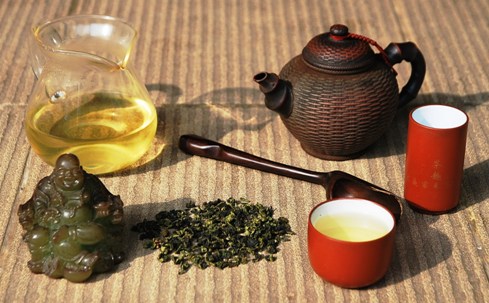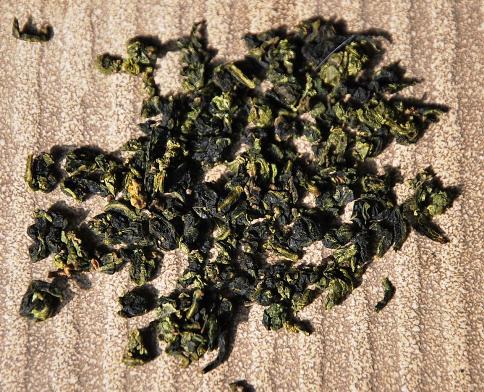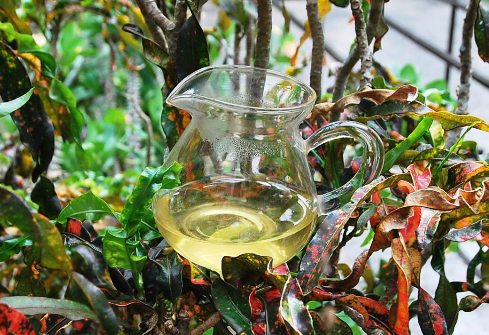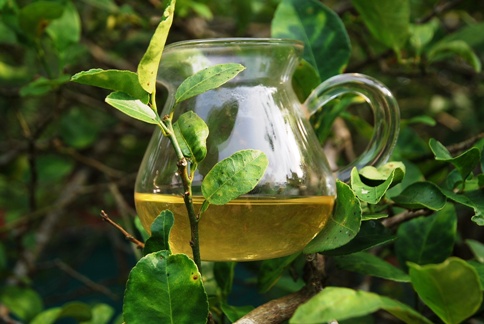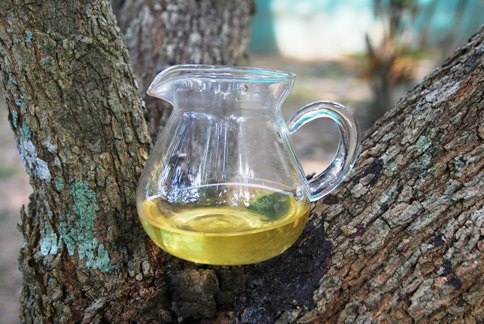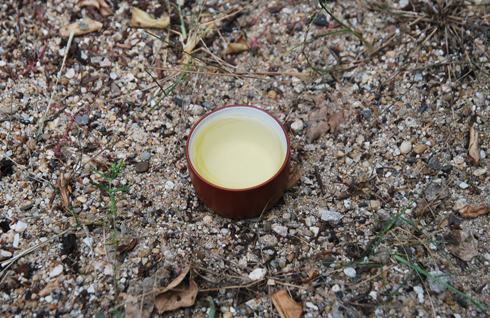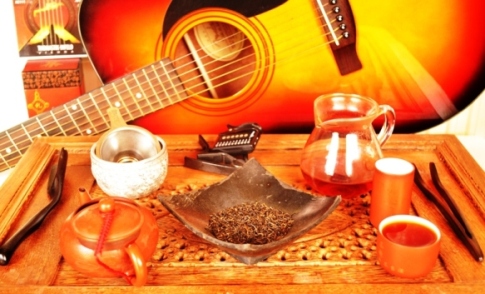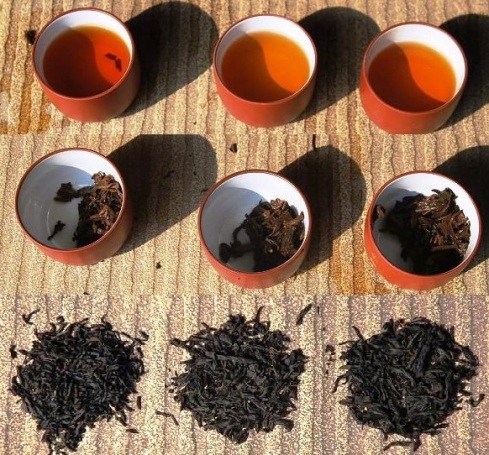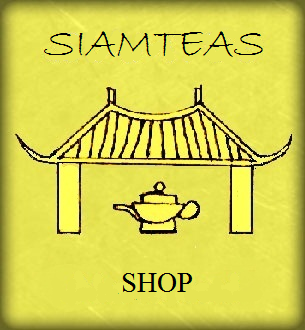October 21, 2013
What bewildered us when we initially took on trying Tie Guan Yin teas from Anxi County, province Fujian, China, was the unusual broad spectrum of quality levels (“grades”) that are offered for this tea. To the confusion contributes that the tea farmers in Anxi don’t seem to adhere to just one grading system, but obviously there are rather several different ones, which appear to be all similarly common. Luckily enough, though, the system used by our producer partner still is one of the most comprehensible ones: it comprises altogether 5 quality levels: A+, A, B+, B, as well as one more nameless class that summarizes everything below these 4 grades. Actually, we did not perceived any of the qualities offered by this producer as “bad”. Much rather, even the nameless class is already a good Tie Guan Yin tea, whereas each class is once again topped by the one superior to it. Principally, the taste of the Tie Guan Yin tea is the same for all grades. The distinctive feature is the intensity of the unmistakable honey-sweet taste and aroma, reminiscent of mature summer flower meadows on the one hand, and the persistence of the same in the mouth and throat on the other. Based on our selection criteria for our offer of selected Chinese teas (in short: only that best of the best), we decided on offering only the two top categories, A (Tie Guan Yin Qingxiang) and A+ (Tie Guan Yin Chunxiang) at Siam Tea Shop.
Qingxiang (grade A, “Delicate Fragrance”) is characterized by its particularly prominent fresh scent, reflecting the tea’s actual taste to the finest nuance, while this scent is slightly less prominent in the Chunxiang (grade A+, “Mellow Tea Class”), where the same seems to be transformed to an even higher taste intensity: the taste of the Chunxiang TKY will linger on the palate and in the whole mouth and throat virtually for hours, thus allowing us to carry it with us as our companion through a good part of the day and even to places and events that usually will rather not accommodate our passion for drinking tea.
Those of you who have read chapter 1 of this article series, “Sourcing tea in China – The Plan + Tie Guan Yin”, knows that Tie Guan Yin Oolong tea shows a range of characteristics that cannot be observed like this with most other teas (if you haven’t read that article yet, it might be worth catching up now). However, my research into the question how the differences between the individual grades come about in the first place returned just another characteristic feature of Tie Guan Yin that distincts thi tea from many or most other Chinese teas: the typical life cycle o the Tie Guan Yin tea plant.
The Tie Guan Yin plant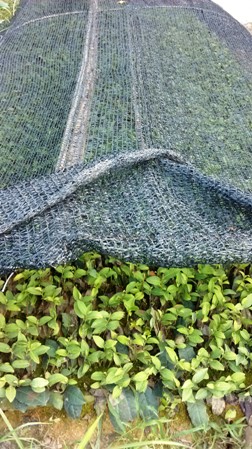 produces the typical Tie Guan Tea in a desirable quality only up to the age of about 8-10 years. Once this age is reached, the Anxi tea farmers dig out their old Tie Guan Yin plants to replace them with new, younger tea bushes. For this, the young seedlings are bred from offshoots of young tea plants in dedicated seedling schools, where the offshoots remain for a period of one to one and a half years, before they can be used to replace old tea bushes in the actual tea garden. The result is a complex, continuous cycle of seedlings, young and old tea bushes that not only requires the concerned tea master’s constant attention, but also represents an essential part of the art of cultivating Tie Guan Yin tea. If this cycle is interrupted,this can mean the end to any Tie Guan Yin operation, as such event virtually has the potential to destroy a family tradition that has been maintained for many generations and been transfered from one generation to the next for decades or centuries.
produces the typical Tie Guan Tea in a desirable quality only up to the age of about 8-10 years. Once this age is reached, the Anxi tea farmers dig out their old Tie Guan Yin plants to replace them with new, younger tea bushes. For this, the young seedlings are bred from offshoots of young tea plants in dedicated seedling schools, where the offshoots remain for a period of one to one and a half years, before they can be used to replace old tea bushes in the actual tea garden. The result is a complex, continuous cycle of seedlings, young and old tea bushes that not only requires the concerned tea master’s constant attention, but also represents an essential part of the art of cultivating Tie Guan Yin tea. If this cycle is interrupted,this can mean the end to any Tie Guan Yin operation, as such event virtually has the potential to destroy a family tradition that has been maintained for many generations and been transfered from one generation to the next for decades or centuries.
The best Tie Kuan Yin tea is produced the young plants’ leaves, with a gradual descent of quality from year to year, this making the the age of a tea plant one of the decisive factors or the grading, i.e. of the quality of the tea it produces. Then, just like with other tea varieties, a second crucial quality factor is the selection of the leaves from a tea bush: the younger the leaf, the higher the quality of the resulting tea. As already explained in the above-mentioned article, with Tea Guan Yin tea,the young buds of the tea plant are not harvested, as they contain too many bitters that are considered as undesirable for this tea. However, first choice, i.e. the best quality, are still the most upper, means the youngest leaves closest to the bud. The result is a highly complex grading system that takes both factors into consideration: once the age of a tea bush and second the age the leaves picked from it.
Consequently, the Tie Guan Yin Chunxiang (grade A+, mellow tea class) consists of the youngest leaves of the youngest tea plants, while the Qingxiang TKY (grade A, delicate fragrance) will also represent youngest leaves, but coming from 1 or 2 years older Tie Guan Yin tea plant. The harvesting of the accurate parties for the respective grades in the correct sequence and with the right timing, just like the consistent monitoring of the taking of offshoots, the breeding of the seedlings and the replacing of tea bushes that have got too old with young ones, in short: the life cycle of the Tie Guan Yin tea plant, represents a highly complex system, whose mastering is indeed a high art form, which has developed, maintained and transfered from one generation to the next in Anxi for thousands of years now.
October 09, 2013
Recently, in the context of the sampling process whose end was marked by the introduction of our Dian Hong Black & Golden Needle and the Bai Mu Dan White Tea into Siam Tea Shop, among others we had also tried a tea, whose package was labeled „Lapsang Souchong“. Inside the package, there were THREE GRAMS of a wild Lapsang Souchong, and the supplier had actually sent the sample along „just for fun“, and with the words „not always available, e.g. not currently, and when it is available, it will probably exceed a price that any of your customers might be willing to pay.” Well, then not…
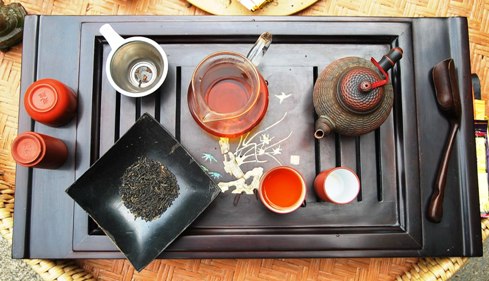 Wild Tongmu Lapsang Jin Jun Mei Tea
Wild Tongmu Lapsang Jin Jun Mei Tea
Of course, we would still – in a tiny circle and on an evening predestined for luxury – try and enjoy the said 3g-sample, which might best be described with the word „revelation“. The whole evening through and spanning at least 6 infusions we would revel in this tea, which we kept infusing even beyond the point, where it was actually done, only to prolong the fantastic aftertaste of this mind-conquering and soul-filling tea just a little more (this actually worked!). A miracle of harmonious balance between a high grade black tea and the smoky taste that is characteristic for Lapsang Souchong. But what did it help? It isn’t always available, it would not be available at all right now, and whenever it would be available, it would be unaffordable. However, the name, Lapsang Souchong, had branded itself into my memory on that evening and had never stopped spooking through my thoughts ever since, so I just couldn’t help myself but setting out to find out, whether there really wouldn’t be any Lapsang Souchong that would be available, affordable, and at least close to that we had tried that night. Besides the pending result of my ensuing efforts, which I soon will present at Siam Tea Shop, the pertaining research and degustations as usually brought about a specific basis of theoretical knowledge, which I would love to share here with the interested reader:
 Wild Tongmu Lapsang Jin Jun Mei tea: dry leaves & buds
Wild Tongmu Lapsang Jin Jun Mei tea: dry leaves & buds
Zheng Shan Xiao Zhong Tea
“Zheng Shan”, translated from Chinese, means about as much as „Original Mountain”. Meant are the Wuyi Mountains, and there in particular the area of „Tongmu“, and it also means that actually only Lapsang Souchong coming from that area, can be righteously referred to as Lapsang Souchong. Characteristic for all teas running under the main category Lapsang tea is the above-mentioned smoking of a black tea during its roasting and processing. However, what distincts one Lapsang from another, besides their taste resulting in a price spectrum ranging from dirt-cheap to unaffordable, is once the quality of the used tea, and second the material and method used for the smoking procedure, Then, third, meanwhile the actual origin might be counted amongst the distinction criteria as well. Today, “Zheng Shan Xiao Zhong” mostly refers to the best quality of classic Lapsang tea, i. e. in principle a Lapsang “Souchong” based on a high quality tea / high leaf grade.
 Lapsang Jin Jun Mei: wet leaves after infusion
Lapsang Jin Jun Mei: wet leaves after infusion
Classic Lapsang Souchong
Traditional, classic Lapsang Souchong used to be a tea produced from the lower parts of the tea plant („Souchong” = „fourth and fifth leave“), so an altogether minor quality, but accordingly cheap tea, whose rather unfavorable taste was both masked and complemented by means of an extended, 8-hours lasting smoking process, in order to make this low quality tea still attractive and marketable. In fact, it is said that though Lapsang Souchong tea used to enjoy quite a high popularity in the west, the Chinese themselves rather considered it as a “Poor-Man’s-Tea”. The tendentiously strong smoking traditionally is done on a fire made from fresh cut pine wood, this giving the classical Lapsang Souchong its typical taste.
Lapsang Jin Jun Mei
The idea to produce a much higher quality „Lapsang“ by using a much higher grade tea (1 bud + 1 most upper leaf or 1 bud + 2 most upper leaves) on the one hand, and smoking it in a much more gentle way on a fire made from well-aged, completely dry pine wood (instead of the fresh-cut one used or the „Souchong“) and for a shorter period, has only been developed after the most recent millennium change. This new Lapsang tea, called “Jin Jun Mei“ has ever since continued to climb up the scale of popularity both in China itself and outside of China, i.e. in Europe, the USA, etc. Climbed up the scale, however, have also the prices for this tea, which clearly can no longer be called a “Poor-Man’s- Tea” now.
Lapsang Tongmu
As already mentioned above, the area of Tongmu is the cradle and the traditional cultivation area for the Lapsang Souchong tea. However, as Tongmu today is a UNESCO protected area and so small in terrain that the production of the classic Lapsang Souchong is not considered as worthwhile there anymore today, the tea producers o Tongmu have readily jumped on the new trend train and by now are producing nearly exclusively Lapsang Jin Jun Mei, as this will score significantly higher prices, while the classical Lapsang Souchong ever more often does not even come from Tongmu anymore, but instead from surrounding areas, from where the tea is merely brought for smoking to Tongmu.
What this means for us
Now, first of all, this meant for us the realization that it had never been „Lapsang Souchong“ tea in the most narrrow sense that we had been looking for in the first place, but rather „Lapsang Jin Jun Mei“ Tea and Lapsang Zheng Shan Xiao Zhong (or together „Lapsang Tongmu“, which would relate to a somewhat wider understanding). Initially, we had tried a whole range of “Lapsangs“ without having the slightest clue of the above-mentioned origins, backgrounds, differentiations and developments, and indeed: in retrospect we could see that the cheaper classic Lapsang Souchongs had fallen through the cracks already at a very early stage of our degustations, while the frontrunners that have meanwhile qualified to be part of our final choice, were in fact Lapsang Jin Jun Mei and Zheng Shan Xiao Zhong teas. Nevertheless, with our studies of online and other sources it came to our attention that also high grade and expensive Lapsangs are still often referred to as Lapsang Souchong by traders, probably simply due to the higher fluency of this term among tea drinkers.
We’ve got an excellent Lapsang Zheng Shan Xiao Zhong for you to try at Siam Tea Shop now! You will find more information and illustration on our relevant product page by clicking on the following link:


